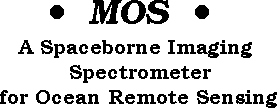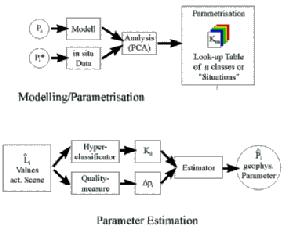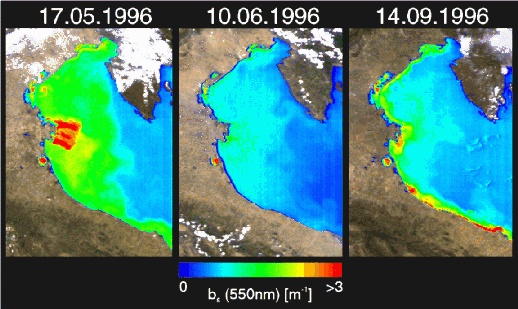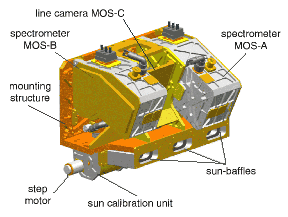
|
Satellite: |

This article has been commissioned by the IOCCG and has appeared in the backscatter magazine, published by the Alliance of Marine Remote Sensing (AMRS)
The German Aerospace Research Establishment (DLR) has developed a visible/near-infrared (VIS/NIR) imaging spectrometer named MOS (Modular Optoelectronic Scanner). Currently two MOS-instruments are operating in orbit: one on the PRIRODA/MIR station and the other on the Indian remote sensing satellite, IRS-P3.
The MOS Instrument
Following this concept, the MOS-complex consists of two imaging spectrometers.
MOS-A is designed for measurement of scattered atmospheric light (turbidity) in one
window with 3 absorption channels of
The design criteria were dictated by the remote-sensing objectives and some
technological reasons. The | |||

Table 1a: Technical characteristics of MOS-PRI
In the design of the instrument, the main focus was on the spectral and radiometric resolution. The spatial resolution was of secondary importance and, with a pixel size of 500 - 700 m, gives an acceptable value for ocean targets. For physical reasons, the field of view can only have small angles. Both MOS-spectrometers reach ±7.0° across track. The overall optical-mechanical design follows the low cost philosophy. In the conventional optical mounting, commercial lens-optics were used for entrance, collimator and imager and plane grating for spectral dispersion. A more sophisticated part is the specially made focal plane hybrid, which consists of a staircase mounting block for 13 CCD-lines to compensate the chromatic aberration of the lenses. The CCD's are specially made lines of 512 elements of size 23 x 480 µm2, with electronic exposure control. |
Beside the entrance slit are two auxiliary slits
for illumination of the inner part of the spectrometer with two small filament lamps for
controlling the dispersion and imaging on the focal plane as well as some of the
electronics. To realise the so called "internal calibration" these lamps are powered
with a highly stabilized current via a 12 bit D/A-Converter. Both lamps of each
spectrometer (MOS-A, -B) can be used at 4 different illumination levels in alternating
or in common mode, giving 4 or 16 output levels for linearity control. At the
beginning of each "calibration cycle" an electromagnetic shutter closes the entrance
slit for measuring the dark current for data correction.
Both MOS-instruments on each mission can be calibrated using the sun as a reference - at PRIRODA via a transmission diffusor and at IRS-P3 via a diffuse SPECTRALON reflector.
Table 1b: Technical characteristics of MOS-IRS
| ||||||||||||||||||||||||||||||||||||||||||||||||||||||||||||||||||||||||||||||||||||||||||

|
The present MOS missions MOS on PRIRODA/MIR The PRIRODA mission is a Russian multisensor remote sensing mission on board a special module of the MIR station. The module was launched on April 23, 1996. Its payload consists of different active and passive sensing instruments in the UV-Visable -Thermal Infrared-Microwave range. It is in orbit at a height of ~ 400 km, at an inclination of 51,6°. The main goal of the PRIRODA programme is the development and testing of different remote-sensing methods and data interpretation algorithms by using measurements in different spectral regions. MOS-P plays the role of providing high dimensional multispectral data in the VIS/NIR range for ocean remote-sensing. The MOS-P instrument tests are a little delayed and are currently going on. MOS on IRS-P3-mission The satellite IRS-P3 is an Indian remote-sensing mission on a sun-synchronous orbit at 817 km and 10:30 am descending node crossing time. It was launched on March 21, 1996. The Indian Space Research Organization (ISRO) has installed a Wide Field Camera (WiFS) with 3 channels in NIR/SWIR range. Table 2 gives some specifications of the IRS-P3 satellite and of WiFS. MOS-IRS is the advanced version of the two instruments. This is true of the spatial and radiometric resolution as well as other technical details. To expand the spectral range MOS-IRS has been equipped with a 1 channel SWIR-camera (Fig. 1). The parameters of this channel are adopted to MOS-B, forming a "14th channel" for target data. The advanced MOS- IRS specifications are given in Table 1. The first image was received on March 23, 1996 and since this date, the instrument has been working well.
|
Table 2: IRS-P3 and WiFS parameters
There is no data recording device on board of the IRS-P3. Data are transmitted in real time to the ground stations Hyderabad in India and Neustrelitz in Germany. These ground stations cover the Indian subcontinent with the adjacent Arabian Sea and Gulf of Bengal and the whole European land region and coastal zones. Currently under discussion is an extension to third party ground stations in other regions of the world of high oceanographic interest. One of the first stations will be on Maspalomas/Canary Island. Other interests from South Africa, Australia, Argentina, Brazil are under negotiations. With the US/NASA a Memorandum of Understanding is in preparation. Data policy IRS-P3 is a bilateral scientific experimental mission of DLR and ISRO. Data acquired from that mission are available to both internal science teams for scientific applications within national and joint activities. As far as WiFS is concerned, for DLR, this is valid only over German territory, since WiFS data outside India are taken care of by special commercial contracts. DLR is interested in a broad application of MOS data, at least in case studies for a wide variety of relevant remote sensing questions. However, since the resources of the DLR mission team are limited, a step-wise approach to include a broader community is considered. During the early phases of the mission, data from MOS- IRS has been available to selected scientific partners exclusively in the frames of joint activities such as ground truthing and calibration campaigns or joint studies for algorithm development. These "pilot" applications in the next step may serve as a nucleus for broader data access to the scientific community. Future joint work will also be discussed during a special workshop on MOS-IRS utilisation (April 28-30, 1997, Berlin). | ||||||||||||||||||||||||||||||||

|
In-orbit performance and radiometric stability
For the MOS payload all health parameters such as temperature and power showed up normal; there was no problem in instrument operation. The overall functioning of the instrument and its performance in orbit is quite excellent. Because there were no problems with the instrument, the redundancy units were not tested for safety reasons. Over the German ground station in Neustrelitz, data from roughly 3 orbits per day were received and processed to generate the Level-1B radiance data files. Up until the end of February 1997, the database contained about 600 passes. After reaching the nominal orbit, 26 sun calibration measurement sequences were recorded. Internal mini-calibration lamps operating at different illumination levels of the focal planes are used to check the spectral alignment, the radiometric stability and the linearity of the CCD-lines. Usually such a control is performed at the beginning of each data take giving also actual measurements of the dark values for correction during ground processing. All received internal control data showed very good consistency compared to the pre-launch values; deviations are below 1.5%. Sun calibration measurements are realized every 2 weeks during terminator crossing over the North pole using the external calibration unit of MOS by special command. The data are recorded in an internal memory of the MOS board computer and transmitted later in the orbit, when the satellite reaches the radio zone of Neustrelitz. The analysis of the data showed a good consistency and stability over time: deviations between recorded data sets are below 0.5%. Detailed analysis of the sun measurements are used to update the calibration of the MOS instrument. MOS interpretation algorithm Spectral high resolution measurements offer the chance to use the fine-structure of the spectral signatures of remote sensing objects to derive geophysical parameters quantitatively. |
 Figure 2 The above flowchart outlines the principle of the PCA-based linear estimation algorithm. ©DLR.
|

|

|
||
|
Interpretation examples
The algorithm can be applied to MOS-B data to derive pigment concentrations (see the example from the Baltic Sea in the February issue of backscatter, pg 16), or to sediment distribution. Figure 3 illustrates the changes in sediment distribution in the Northern Adriatic sea. The May image was taken after heavy rainfalls causing the large plume in the mouth of the Po river. The water model was provided by JRC Ispra. |
References
Krawczyk H., Neumann A., Walzel T., 1995: "Interpretation Potential of Marine Environments Multispectral Imagery", Proceedings of the Third Thematic Conference on Remote Sensing for Marine and Coastal Environments, Seattle, Sept. 1995, pp. II-57 - II-68 Neumann A., Krawczyk H., Walzel T., 1995: ,A Complex Approach to Quantitative Interpretation of Spectral High Resolution Imagery", Proceedings of the Third Thematic Conference on Remote Sensing for Marine and Coastal Environments, Seattle, Sept. 1995, pp. II-641 - II-652, 1995. | |
This article appeared in the May 1997 issue of the backscatter magazine,
published by the Alliance of Marine Remote Sensing (AMRS).

 = 1.4 nm in the O2A-band near 760 nm
(Note:
= 1.4 nm in the O2A-band near 760 nm
(Note: 